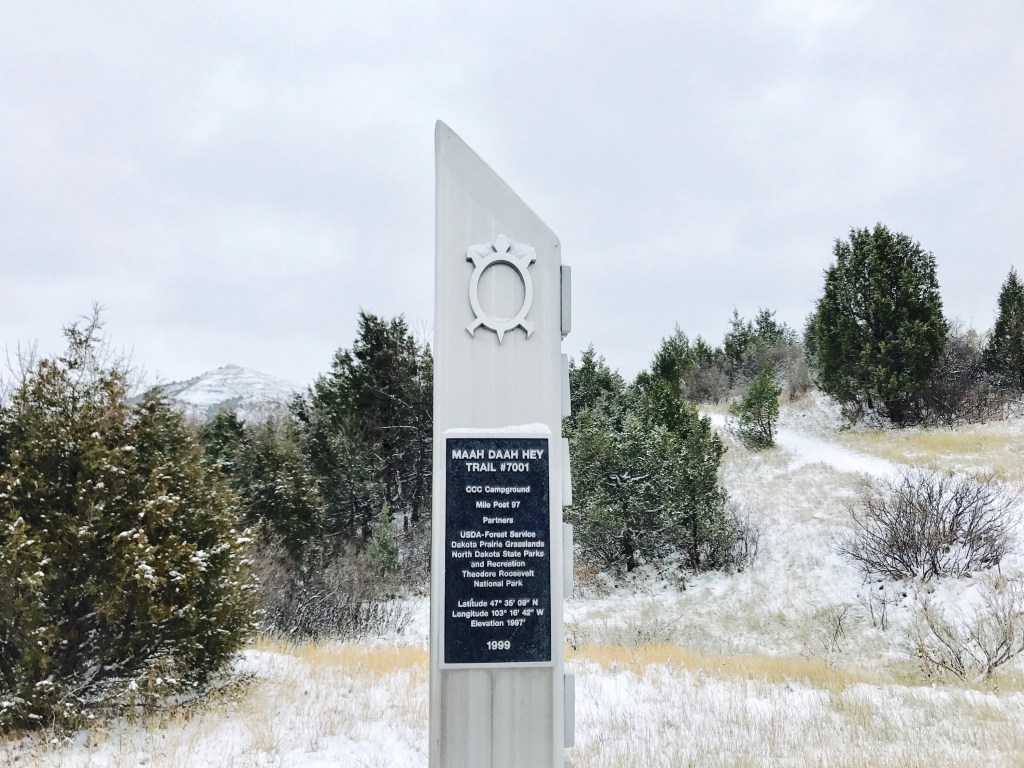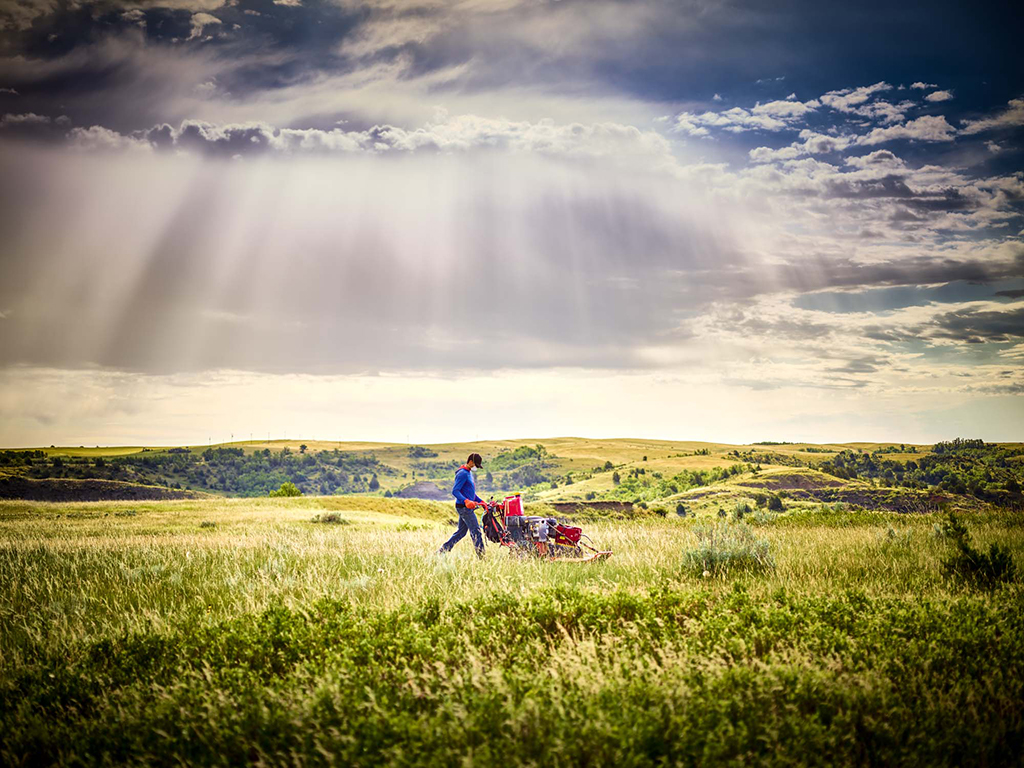Through our Keepers of the Outdoors series, we’ll introduce you to people who protect and care for our wild places.
Have you ever loved something so much that you would walk 200 miles for it? Through heavy brush? With a push mower? Nick Ybarra has.
“It was here that the romance of my life began.” —Theodore Roosevelt
Theodore Roosevelt was often given to waxing poetic about North Dakota’s Badlands, and it’s easy to see why. The earth rises and plummets in sepia folds that form dramatic buttes and canyons, dotted with dark pine trees. Prairie grasses bend and twist in the ever-present wind and mingle with the brilliant reds and muted browns that make up much of the clay-heavy soil. Roosevelt is known to have cited his time in North Dakota as being the reason he fell in love with the outdoors and set him on the path to becoming President.
It is this same North Dakota landscape that was Nick Ybarra’s first love.
Ybarra has wide, dark eyes and an easy smile. A black ball cap emblazoned with his company’s logo seems permanently affixed to his head, and acts almost like a weathervane, rotating with his mood. When he is serious, the cap’s bill points directly ahead as he leans to talk. As he begins to relax, his hands seem to unconsciously rotate the cap’s bill slightly to the side, giving him an even more youthful appearance. At 34, Ybarra has a habit of quoting our 26th president. Ybarra describes himself as an average guy, quoting Teddy Roosevelt, ‘“an average man … but I work harder at it than the average man”’.

Nick Ybarra | Photo: Chad Ziemendorf
Ybarra fondly remembers moving to small but prosperous Watford City, North Dakota, from Bismark after the oil boom of the early ‘80s. Though he always liked North Dakota, it took two wheels and miles of sprawling grasslands for him to fall in love. He was just 18 years old and the closest bike shop was over an hour away (so he rode a hundred-dollar bike from a big-box store), but from the moment his tires hit the trail, Ybarra was hooked.
Since moving to Watford, Ybarra has spent thousands of hours and almost every day either riding or caring for North Dakota’s premiere long trail.
“Mountain biking is my favorite sport, it is my hobby, it is my exercise plan, it is my long-term health insurance policy, it is my sanity, it is my passion.”
The Maah Daah Hey Trail is more than 100 miles long and winds through rolling grasslands, dramatic plateaus and expansive valleys of the Badlands. Local riders joke the most technical aspect of the MDH is dodging the cow patties that blossom on the trail in the summer months. The trail gets its name from the Mandan Indians, a North Dakota tribe whose name means “something that will be around for a long time.” A simple depiction of a turtle marks each of the trail’s signs and mileposts, a symbol of resilience, determination and perseverance that characterize the trail.

Photo: Zoe Rom
After Ybarra’s first excursion on the MDH, he did everything he could to get back out on the trail. One of his first dates with his now wife, Lindsey, was on the trail. He took a job on a drilling rig in 2010, working for two weeks at a time and riding the MDH during his two weeks off. He loved the solitude he found on the twisting prairie singletrack, the rush of adrenaline that came with nailing a descent or the breathless exhilaration experienced after a grueling climb.
“Mountain biking is my favorite sport, it is my hobby, it is my exercise plan, it is my long-term health insurance policy, it is my sanity, it is my passion,” said Ybarra.
In the summer of 2011, the MDH started to disappear. After a particularly wet spring, rough prairie grasses began to sprout on the trail, all but obscuring the already faint singletrack. Due to budget cuts, the U.S. Forest Service (USFS), which manages the Little Missouri National Grassland through which the MDH winds, was unable to keep up with the encroaching prairie—the MDH was in danger of vanishing altogether.
“At least half the trail was dead, gone, extinct and the rest of it was not very enjoyable, not like it once was,” said Ybarra. “I was willing to do just about anything to save the MDH from disappearing forever.”
So, he did what anyone whose true love was threatened would do. He got a lawn mower.

Ybarra mows the 100-mile Maah Daah Hey—in both directions. Photo: Chad Ziemendorf
“You know, Roosevelt said the best thing in life is to work hard at work worth doing.”
The MDH can be narrow and winding, and it traverses sections of wilderness and grasslands that restrict the use of motorized vehicles, requiring that Ybarra use a push mower to cut the grass on both sides of the trail—totaling well over 200 miles. Although a handful of close friends eventually helped Ybarra with the mowing, he logged well over 100 miles himself. Terrain that is intended to be fun for horseback riding and mountain biking is less welcoming to the unwieldy grass-cutting tool, rendering descents a bit scary and uphill pushes incredibly laborious. Like everything that lives in North Dakota, prairie grass is tough. Really tough. And a sturdy blade and persistent mower is required to cut it.
“As humans, we have this undying passion to do everything we can to save what we love,” said Ybarra. So, he set out mowing every bikeable section of trail. He started at the CCC trailhead near his hometown of Watford City and mowed all the way to nearby Medora, where President Roosevelt had his ranch.
Growing up around ranches and working on an oil drill, Ybarra has never shied away from hard work and manual labor.
“You know, Roosevelt said the best thing in life is to work hard at work worth doing.”
However, Ybarra realized that single-handedly mowing more than 200 miles of trail was hardly a sustainable way to save his beloved trail. The best way to preserve the MDH was to share it.
One thing that makes the MDH so attractive to riders like Ybarra is the solitude it provides. Its remote location and relative obscurity have earned it the nickname “North Dakota’s best kept secret.” In order to draw attention to conservation and restore the MDH to its former glory, Ybarra decided to host a race.
In 2012, Ybarra held the first MDH 100—a grueling race that would take riders through Ybarra’s favorite sections of trail. Still working part time on an oil drill, Ybarra had no idea how to organize a race. He quickly learned how complicated it can be to organize such a large event as well as scouting and marking the race course himself, along the way discovering that cows love to eat pin flags and ribbon.
The first year, 60 riders showed up to race. The 107-mile course of remote singletrack wound in and out of the grasslands, and several riders got lost on cattle trails that led them on miles-long detours off route. However, racers loved the long and scenic trail, and North Dakota’s best kept secret was out. This year, 560 riders rolled up to the starting line.
“I love sharing my favorite thing in the world with other people. I love getting them out there and seeing that glitter in their eye when it clicks and they get it,” said Ybarra, “you get to fall in love all over again.”
“I knew the only way to save the MDH trail to its former glory was to roll up my sleeves and partner with the USFS.”
Watford City is a small community with only a handful of local riders, and it’s a tight-knit group. Everyone knows when anyone else is riding, and bikes tend to circulate within the small group, trading hands as group members upgrade. Watford City and the surrounding region is distinctly working class, with the majority of people working either in oil extraction or on ranching operations. Ybarra hopes to get as many area residents out on the trail as possible.
“I believe in staying active, but I also believe you really have to enjoy it, and we have this incredible trail just a few minutes from where we live, and I want to share that,” said Ybarra.
Though Ybarra was largely maintaining the trail himself with just a handful of volunteers, he was still searching for a way to get more people involved in his passion project, whether through riding or conservation. In 2013, Ybarra founded Save the Maah Daah Hey, a nonprofit that worked in partnership with the USFS to maintain the MDH. In the past two years, Ybarra has had the help of 20-40 volunteers dedicating well over 1,100 hours of volunteer trail work to keep the trail in shape for year-round riding.
“I knew the only way to save the MDH trail to its former glory was to roll up my sleeves and partner with the USFS to make the MDH findable, usable and enjoyable,” said Ybarra.
Even so, it’s not enough to keep the trail maintained, and Ybarra believes the trail’s best chance at survival depends on bringing in riders from out of town. In 2016, Ybarra was able to quit his day job and begin work as a full-time race director. He now hosts eight events each year on the MDH, including the 100-miler, a gravel race, a Christmas fatbike race, kids races, trail runs and even a winter race that takes bikers, skiers and snowshoers down a frozen creek that traverses the trail.
The North American Trail Symposium awarded him an Outstanding Trail Leaders award in 2017 for his work restoring the trail and building a mountain biking community dedicated to stewardship. Now, he has two young daughters who are just old enough to start biking the MDH, and he plans to spend as much time with his favorite people, and favorite trail as possible.
Said Ybarra, “Sharing the thing that you love the most with the people you love, and seeing them fall in love, man … there’s nothing like it”
